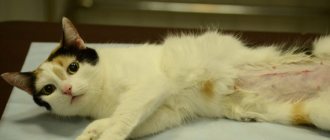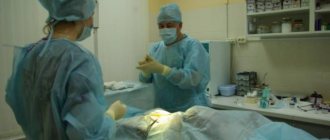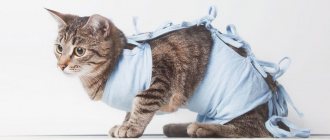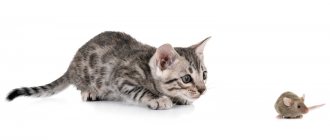Sterilization of cats includes mandatory post-operative care for sutures. Complications after surgery are a rare occurrence, but for the safety of your pet it is better to know all the possible nuances. Most often they arise due to the fault of an inexperienced owner who has committed prohibited actions.
Why preoperative preparation is important
Before the operation, the pet must be prepared. She is vaccinated within a month, and treated against worms within 1.5 weeks. The last feeding is carried out no later than half a day. Water is allowed only 3 hours before the procedure.
This preparation helps to avoid situations that weaken the immune system and eliminate vomiting, which can lead to aspiration pneumonia. Before administering anesthesia, veterinarians check the animal's heart rate and lung function and weigh it. This is necessary to calculate a safe dosage of anesthesia.
Types of cat sterilization
Caring for your cat after surgery depends on the type of sterilization and anesthesia. To eliminate reproductive function, 3 methods are used:
- Tube sterilization
. The animal's fallopian tubes are ligated. This prevents further reproduction, but preserves sexual desire and estrus. The method is used less and less, as it retains the risk of inflammation and oncology of the genital organs.
- Ovariotomy
. The surgeon removes the ovaries but leaves the uterus. The operated patient stops estrus, but the risk of uterine disease remains.
- Ovariohysterectomy
. The safest and most effective method, which involves the removal of all internal genital organs. The risk of developing cancer is completely eliminated.
The operation itself takes less than an hour.
The rest of the time is spent recovering from anesthesia. There are 3 options for waking up:
- Immediately after the anesthesia is turned off. Characteristic of gas anesthesia, which puts the patient into a sedative state. Despite its low toxicity, it is used only in a limited number of veterinary clinics due to a lack of equipment and medicinal substances.
- Within 8 hours. A combination of epidural anesthesia and muscle relaxants. It is also low-toxic, but requires a lot of experience from the surgeon. An error when working with an animal's spine can lead to loss of sensitivity in its paws for up to 2 days.
- Within 5-24 hours. The most common method is the use of analgesics and muscle relaxants. This type of anesthesia is the most severe, so the pet can recover from it for almost the whole day.
Under general anesthesia, the animal's reproductive organs are removed using a scalpel or endoscopic equipment and stitches are placed. Caring for them depends on their type.
Character of a cat after sterilization
Before sending their pet for surgery, owners ask the veterinarian whether the cat’s character changes after sterilization, and how this happens.
You should not expect drastic changes in the animal’s behavior after sterilization, but some changes in the pet’s body that affect its character do occur after surgery.
Changes in the pet's behavior are observed during the rehabilitation period, when the animal recovers from anesthesia and feels discomfort in the suture area.
Lethargy and apathy of a pet are natural, since its body is weakened.
The slowdown of metabolic processes that invariably occur in the animal’s body after sterilization entails certain changes in the behavior of the animal itself.
The behavior of a cat after sterilization largely depends on the original character of the animal. If the pet was aggressive initially, then after surgery, and especially in the first weeks after, it may hiss and rush at the owner.
After ovariohysterectomy (removal of the uterus and ovaries), metabolic processes in the animal’s body slow down.
The cat's appetite increases, even if before the operation the animal did not have a particular craving for food. Inactivity and obesity are the main signs of metabolic disorders in the body.
But even in this case, the character of the cat after sterilization will depend on individual characteristics. Some pets become very affectionate, homely and kind, while other individuals do not change at all in their preferences, remaining just as active and mobile.
The behavior of cats after sterilization largely depends on the timing of ovariohysterectomy.
Thus, veterinary experts say that in order to achieve serious changes in the character of the pet, it is important to carry out sterilization at the age of 6 to 9 months.
This period is the most favorable, since during this period their body is fully mature, but the first estrus (sexual heat) has not yet occurred.
How a cat’s character changes after sterilization is difficult to predict. But at an early age, the cat’s body is in the formative stage, and the effect of specific sex hormones is not significant.
Carrying out ovariohysterotomy during this period will make it possible to stop such signs that are not desirable for the owner, such as sexual instincts, marking of territories, and defending territorial boundaries.
After sterilization, a cat is more affectionate if the operation is performed at an early age. Owners of cats sterilized at an early age claim that the animal remains an “adult kitten” for life, since sex hormones have no effect on the body.
The growth and development of the musculoskeletal skeleton undergoes changes, because the development of the genital organs does not require such an amount of energy. Due to this, the height and build of cats differs among sterilized cats.
Before performing an operation to sterilize a cat, it is necessary to undergo a series of diagnostic tests at a veterinary clinic.
This will allow timely detection of chronic diseases or tumor processes in the body. It happens that after sterilization, a cat hisses and rushes at the owner or other animals in the house.
This may be due to various diseases that bother the animal. Due to severe hormonal disorders that arose even before the operation, the animal can also show severe aggression towards others.
If an animal shows aggression before surgery, and the owner wants to eliminate this problem through sterilization, then in this case doctors do not recommend surgical intervention.
It is not possible to eliminate aggression in this way; in addition, as a rule, animals with hormonal imbalances become even more inadequate than before.
The first day after surgery
After surgery, the pet can be left in the hospital or taken home immediately. In the second case, it is necessary to understand all possible nuances, since responsibility for the health of the furry patient falls on the owner. Also, the most popular option for sterilization at home remains.
Hospital
Most veterinary clinics offer to leave the animal in their hospital during recovery. This eliminates the need for independent manipulation and guarantees emergency assistance if complications arise.
The disadvantages of this option include the high price and psychological factor. If a pet is strongly attached to its owner, then it will be difficult for her to be left alone in an unfamiliar place. In addition to stress, she may harbor resentment, which will change her behavior forever. There is also always the risk of unscrupulous personnel. You won’t be able to track their work, so it’s safer to trust yourself.
Delivering a cat home
If you decide to take care of your pet at home, prepare for it a warm blanket, disposable diapers and a comfortable carrier. Sometimes a veterinarian will hand a furry patient over to her owners after she regains consciousness. He also needs to make sure the bleeding stops.
After receiving your pet from the doctor’s hands, place her on her right side in a carrier with diapers and cover her with a blanket. This position reduces the load on the heart and prevents vomit from entering the trachea if the cat suddenly feels nauseous. And this happens often after anesthesia.
Coming out of anesthesia
After returning home, place the pet on a soft bedding located on the floor and warm it with a heating pad. Anesthesia disrupts natural thermoregulation and coordination. Without your help, the animal may freeze or get injured if it gets up from an uncomfortable place.
Also make sure you have diapers. Before complete awakening, involuntary bowel and bladder emptying is possible.
If you took your pet without waiting for her to wake up, then you will have to take care of moisturizing her eyes. Animals under anesthesia often have their eyes open but cannot blink them. Because of this, the mucous membranes dry out and become injured. For hydration, you will need to periodically close the cat's eyelids or hydrate the cornea with "artificial tears."
After awakening, attempts to escape are possible in order to hide in an inaccessible place. This occurs due to a lack of coordination and lack of understanding of the events taking place. Try to calm your pet down with affection and conversation. On the first day, keep an eye on her to help if necessary.
Is it possible to feed and water a cat?
Eliminate feeding for one day, but do not forget to give the animal water immediately after waking up. To be safe, use a syringe and watch your swallowing movements. In their absence, your pet may choke.
On the second day, offer food, but no more than ⅓ of the usual portion. By this time, the pet will begin to drink on its own. Interest in food appears on the second or third day. Increase the number of servings gradually, offering low-fat and easily digestible dishes.
It happens that a cat demonstrates severe hunger already in the evening of the first day of surgery. Then you can give her some low-fat broth. Dairy products and solid food should not be given - the animal is likely to vomit.
Recovery of cats after surgery
1. Strictly follow your veterinarian's recommendations.
The word of a veterinary specialist is law. Follow the recommendations and do not self-medicate. If the doctor has prescribed antibiotics for your cat, give it antibiotics for exactly as many days as prescribed, even if it seems to you that the pet has already recovered. All instructions must be followed - the success of rehabilitation depends on this.
2. Monitor your pet's condition.
If possible, take time off for the first few days after surgery. A weakened cat will need your help and careful monitoring of its condition: temperature, stool, stitches, etc. You should always have the veterinarian’s phone number at hand. In case of deterioration or if you have any questions, be sure to contact him.
3. Treat seams.
A veterinary specialist will definitely provide recommendations for treating sutures. Hygiene must be maintained so as not to provoke inflammation.
Under no circumstances should wounds be treated with iodine or brilliant green: this will cause a burn. Typically, veterinary specialists recommend chlorhexidine or Vetericin solution - powerful and completely safe antiseptics. By the way, they are applied painlessly.
4. Don't let your cat lick the stitches.
The cat should not be allowed to lick the stitches, otherwise they will become inflamed and will not heal. Block “access” to the seams with a blanket or a special collar.
5. Organize an ideal resting place for your cat.
During the day after surgery, the cat's coordination may be impaired, because... The effect of the anesthesia will still last. To prevent her from accidentally falling and injuring herself, arrange for her a quiet, warm place on the floor, away from drafts, doors and household appliances. The same applies to weakened pets. If your cat is not yet strong enough, it is not advisable to place it on high surfaces (bed, chair, etc.).
Cats also experience a drop in temperature after surgery. The owner's task is to prevent the pet from freezing. A blanket and a soft, warm bed with sides will help you do this.
6. Restoring immunity!
A nutritious diet gives the body the strength to recover. A veterinarian will prescribe a special diet for your cat.
To speed up the rehabilitation process, introduce special prebiotic drinks (Viyo Recuperation) into your diet. Prebiotics have already proven themselves in human therapy as an effective means for strengthening the immune system and have recently been produced also for dogs and cats. In addition to strengthening the immune system, they have a good effect on the intestines. Prebiotics stimulate the contraction of its walls, which is very important in the postoperative period. The effect of anesthesia causes atony (slowing down the movement of the intestinal walls), leading to constipation. If the operation is abdominal, in the first days it is painful for the pet to push, and constipation causes great discomfort. Prebiotics solve this problem.
7. Water.
Make sure that clean drinking water is always freely available to your pet.
8. Peace
During the rehabilitation period, the animal requires rest. He should not be disturbed by other pets, children, loud noise or other irritants. Rest and sleep are the most important steps to recovery.
9. The owner must take care of the cat.
After surgery, a weakened pet experiences stress, and sometimes even fear, and may behave inappropriately. Communication is not what he needs at this stage. It is advisable to disturb the cat as little as possible, and entrust care to one person - the one she trusts most.
10. Limit physical activity.
During the first time after surgery, physical activity is contraindicated for cats. Over time, your pet's life will become active and energetic again. But how quickly this should happen and at what pace – a veterinary specialist will tell you.
Be careful and take care of your pets. We wish them a speedy recovery!
What you will need
Even before the procedure, take care of a place for rehabilitation and special protection to prevent the suture from tearing. Also, be sure to consult with your doctor about treatments for the incision and medications needed in case of complications.
Blanket, bandage or collar
Until the wound on the abdomen heals, you will have to wear a special cotton blanket with ties at the back. Due to discomfort, the animal will walk unusually or refuse to move at all. After removing the blanket, mobility returns to normal.
An Elizabethan collar is recommended as additional protection. It will prevent you from removing the bandage and licking your wounds on your own.
Even if the female was operated on laparoscopically, she will have a small stitch on her side. Some cats do without a bandage and collar, since they do not lick the seam, while others will need the entire arsenal of protection against licking.
Medicines
All medications are prescribed individually. They are usually necessary for elderly or debilitated patients. If there is no disorder and you feel stable, taking antibiotics, painkillers and vitamins is not required.
Seam treatment products
Caring for the suture left after sterilizing a cat takes 7-10 days. To process it you will need cotton pads or a thick bandage. Ordinary cotton wool can get stuck in the wound and cause suppuration. Chlorhexidine 0.05%, healing sprays and Levomekol ointment will also be useful.
Place for rehabilitation
Prepare in advance a soft, horizontal place away from open windows and heating appliances. Shade the room with curtains and make sure the room temperature is at least 22°C. A heating pad or light blanket is suitable for additional heating.
Nursing pets will have to be temporarily separated from the litter. While feeding, kittens can injure the wound. It is also recommended to avoid contact with children or other pets that could accidentally harm the operated cat.
Postoperative suture care
During the rehabilitation period, the owner of a sterilized pet should pay close attention to the care of the surgical suture. As a rule, recommendations on how to treat a suture after sterilization of a cat are given by the veterinary specialist who operated on the animal.
Many clinics practice treating the suture immediately after surgery with aluminum spray, and in this case additional methods are not needed.
If suture treatment is necessary, it begins on days 2–3 after surgery. To quickly heal a wound, a solution of brilliant green (brilliant green), chlorhexidine, betadine, chemi-spray, hydrogen peroxide, and Levomikol ointment are often used as an antiseptic. It is better to process the seam with an assistant, so the animal is less stressed and the manipulation is carried out more carefully.
How long a cat’s suture heals after surgery depends on many factors: the qualifications of the surgeon, the individual characteristics of the animal’s regeneration, proper postoperative care, etc. On average, complete healing occurs on the 10th - 12th day after surgery
On the 5th day, when processing the seam, you need to pay attention to its condition. It must be dry, its edges should not diverge by more than 1 mm
Not all external sutures need to be removed during sterilization. There are techniques for applying a special suture with absorbable material. The veterinarian who operated on the animal will tell you in detail whether and how to remove the stitches for a cat after sterilization. There is nothing complicated about this manipulation. You need to know the number of stitches, have small scissors and tweezers. Tools must be disinfected. The thread with the knot is pulled out with tweezers, and one thread is cut with scissors. And so all the seams are gradually removed. If for some reason it is not possible to remove the stitches yourself, the best option is to have it done at a veterinary clinic.
How long a cat recovers after sterilization depends on a number of factors:
Timeliness of the operation. If it is carried out within the time frame recommended by experts, the animal has not experienced estrus, there has been no birth or pregnancy, tissue regeneration occurs quickly.
Age of the animal. The operation of a young individual is characterized by faster rehabilitation than sterilization of a mature and elderly cat.
Surgeon's qualifications. A competently performed operation with minimal tissue trauma, correct application of ligatures, and neat postoperative sutures contribute to rapid granulation and wound healing.
Postoperative care. Careful adherence to the recommendations of a veterinary specialist, correct actions on feeding, maintenance, and care of the postoperative suture will reduce the animal’s recovery time.
Complications in the postoperative period. The presence of all kinds of health problems after sterilization significantly increases the cat’s recovery time.
Care by day
During rehabilitation, it is recommended that one of the household members take a vacation. Usually a week is enough for complete recovery.
The instructions for caring for a cat after sterilization on a daily basis are simple. If at least one of the points does not correspond to the current situation, contact your veterinarian. Any deviation is a serious cause for concern.
First day
On the first day, refuse feeding and force-drink your pet using a syringe or pipette. Do not allow active movements and regularly moisturize the cornea. Monitor your bladder and bowel movements. If your pet intends to do this in the tray, place a towel under it to increase the stability of the limbs. You can simply hold the animal.
Lack of appetite, lethargy, vomiting and spatial disorientation are natural signs that accompany recovery from anesthesia. If pain occurs, contact your doctor and discuss acceptable analgesics. Increased aggression, frequent meowing and prolonged lack of movement will help you learn about unpleasant sensations.
Second day
Lack of bowel movements on the second day is a cause for concern. You will also have to contact your doctor if you are unable to move.
The pet should begin to move around and show interest in the water. Offer her some kefir or chicken broth. If you use dry food, temporarily replace it with wet food.
Limit movement within one room. It should contain a sleeping place, a tray, and feeders. Avoid freezing and rub the paws if they do not warm up on their own. You can also apply a heating pad to them.
The third day
By the third day the pain completely disappears. The animal becomes more active and begins to be interested in food. Increase your portions, but don’t rush back to your usual sizes. Let's eat more often, but little by little.
Measure your body temperature in the morning and evening. If both times are higher than normal, contact your veterinarian. This situation often requires antibiotics. Too low values are no less dangerous.
In case of prolonged absence of bowel movements, it is recommended to take laxatives. They accelerate intestinal peristalsis and stimulate fecal waste. You can find out which laxatives your cat can use by calling your veterinarian.
Fourth day
By the fourth day, the condition will completely stabilize, but to be on the safe side, it is recommended to continue to limit the space. Lack of bowel movement for more than 3 days requires urgent veterinary intervention. Don't try to solve the problem yourself and seek help.
Fifth day
On the fifth day, the animal can be released for walks in the yard or in other rooms. All this time, do not forget to monitor his safety. From this day on, the first jumps on low surfaces are allowed.
When examining the wound, scarring may be detected. Swelling and redness should disappear.
Sixth and seventh days
Behavior is completely normalized. In the absence of inflammation and suppuration on the wound, removal of the suture material is allowed.
If the cat was operated on laparoscopically, jumping and movement are allowed already on the 2-3rd day. The small seam does not come apart and does not cause severe discomfort to the cat. However, its sterility must be monitored no less carefully.
Coming out of anesthesia
Every owner who decides to take measures such as sterilization should know how to care for a cat after castration.
Coming out of anesthesia is a long process that requires patience.
Here are a few nuances of which:
- At first, the cat will not be able to control the coordination of its movements. Lameness and involuntary running are possible.
- The animal may try to stand up or, conversely, fall on its side. The limbs most often do not obey the pet, but there is no need to worry in such a situation.
- As a result of poor health, a cat may meow or purr - this is a normal reaction.
- The animal does not fully control the urge when needed.
- Vomiting and retching should be a reason to consult a doctor, since this may be a complication.
- In some cases, an increase in body temperature may occur after surgery. If the cat's nose is hot for a long time, it is necessary to periodically measure the indicators using a thermometer.
- You should not feed your cat immediately after regaining consciousness. Water can only be given when four hours have passed after the operation. If the animal has been sleeping for a long time after the end of the procedure, then some liquid can still be offered.
- You can feed the animal only one day after castration. It is best to offer your cat food, but do not try to feed it yourself. The pet will eat on its own as soon as its appetite returns.
- Often the operated animal sleeps for about seven hours. Then the effect of the anesthesia weakens and the cat begins to wake up. During the day after the operation, the cat will not be able to adequately respond to what is happening. She will be sleepy, lethargic and may also be aggressive.
If the cat is poorly oriented and tries to run, it is necessary to catch it and put it back. Once the cat has calmed down, you can leave her. It is best if your pet sleeps on the right side, as sleeping on the left side can make the heart work harder.
What complications may arise?
Complications rarely occur during planned surgery These include:
- intra-abdominal bleeding;
- prolonged (more than 4 days) redness and swelling of the wound;
- the appearance of lumps and suppurations on the operated abdomen;
- prolonged (more than 3 days) increase or decrease in temperature.
If you notice pale skin, traces of blood on the suture material or loop, severe abdominal pain, strange discharge or other alarming symptoms, contact your veterinarian immediately. The operation may need to be repeated.
Complications after cat sterilization
In general, complications after more or less competently performed sterilization are rare. As a rule, they are encountered with gross and gross violations of the rules of asepsis and antisepsis.
The consequences of such operations include:
- Peritonitis , that is, inflammation of the peritoneum. Fecal peritonitis occurs when the lining of the intestinal loops is somehow damaged during surgery. The pathology is extremely difficult, very often ending in death.
- Inappropriate behavior. In practice, it is quite common to observe a cat behaving strangely after surgery (the first three days). This does not apply to true complications, but sometimes (when using old and very “heavy” drugs for anesthesia) the animal’s nervous system suffers greatly. There is evidence that due to poor-quality premedication and basic anesthesia, a cat can even develop epilepsy.
- Internal bleeding. It occurs when the ligature was applied incorrectly to the uterine stump, or it was initially of poor quality.
- Inflammation and suppuration of the sutures. Often, neither the veterinarian nor the owner is to blame for this. The problem is an animal that licks and scratches this area constantly.
- Dehiscence of the postoperative suture. It ends either in bleeding, or purulent inflammation, or peritonitis. Often this is a consequence of the cat independently removing postoperative sutures.
Processing and removal of seams
Drug treatment is carried out only as directed by a veterinarian. Most often, after surgery, permanent sutures are applied that dissolve on their own. The owner needs to check the cleanliness and dryness of the suture material, since the ingress of dirt or moisture can lead to suppuration.
If the suture material is removable, follow the advice of your doctor and do not remove it before the specified time. For quick wound healing you will need:
- Check it twice a day for dirt or discharge.
- Do not damage the suture material or do it yourself. An abundance of antiseptics and sprays inhibit regeneration.
- Keep the rehabilitation area clean and avoid swimming.
After 7-10 days and the wound has completely healed, make an appointment to have your stitches removed. If you decide to do this yourself, watch the instructional video so you don’t get confused when cutting the threads. A safe procedure involves sequential removal of the outer suture material by pulling out the outer one. A mistake in this procedure can lead to infection, so it is better to entrust it to specialists.
First days after surgery
Caring for a cat after castration is not difficult for the owner. The only thing you need is enough time to monitor the pet’s condition.
It is best to place the animal in a quiet place, laying it on soft bedding. Direct sunlight can damage the cornea, so you should avoid exposing your cat to the sun. It is best to limit the access of other animals and small children to a recovering cat.
Before waking up from anesthesia, the cat will still have open eyes, so it is necessary to periodically instill eye drops into them.
For 7-10 days you need to monitor the condition of the seam. It must remain dry and clean. Wetting and suppuration of the seam are not allowed. It is necessary to treat the seams with an antiseptic (hydrogen peroxide, dioxidine). Sometimes the doctor may prescribe the use of additional wound healing agents.
Swelling and swelling around the wound is allowed to occur for several days. After some time, these symptoms will disappear on their own.
After surgery, a long-acting antibiotic is injected. The next injection must be given 48 hours after the first. Both the doctor and the owner can give the injection.
Sutures are usually removed 7-10 days after surgery.











